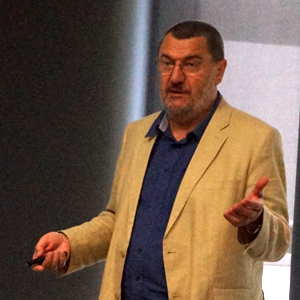Friday, 24 July 2015
Prof Velimir Radmiloviã talks about Zigzag Inversion Domain Boundaries in Functional Oxide Nanowires
During an ICN2 Seminar, presented by Prof Jordi Arbiol, Prof Velimir Radmiloviã explained how he and his team at the University of Belgrade (Serbia) recently discovered a novel method to produce M2O3(ZnO)n polytypoid nanowires.

Prof. Velimir Radmiloviã, from the Nanotechnology and Functional Materials Centre at the University of Belgrade (Serbia) explained in an ICN2 Seminar how he and his team recently discovered a novel method to produce M2O3(ZnO)n polytypoid nanowires (MZO, where M could be various elements, such as In, Ga, Fe). They demonstrated nanostructured enhancement in both thermal and electrical properties in ZnO-based polytypoid nanowires. Prof Jordi Arbiol, Group Leader at ICN2, presented the talk.
Due to the decoupling of certain electrical and thermal properties, these polytypoid nanowires, which contain nanometer-scale periodic compositional and structural features, are promising materials for a variety of applications. This new concept of structure control at atomic level is in agreement with the theoretical prediction that it is possible to increase the material-dependent figure of merit by using low dimensional materials, attributed to electronic band structure changes and enhanced interface phonon scattering. It appeared that control of lattice phonon transport contribution is essential to improve thermoelectric properties of ZnO based nanowires.
Atomic resolution high angle annular dark field (HAADF) imaging is used to perform a detailed structural analysis on the M2O3(ZnO)n nanowires, unambiguously determine the location of indium within the structure and to evaluate lattice strain and the presence of defects. Existing models for the crystal structure of indium zinc oxide (IZO) and indium iron zinc oxide (IFZO) conflict with electron microscopy data. Prof Velimir Radmiloviã and his team propose a model based on imaging and spectroscopy of IZO and IFZO nanowires and verify it using density functional theory.
The model features a {121l} “zigzag” layer, which is an inversion domain boundary containing 5-coordinate indium and/or iron atoms. Higher l values are observed for greater proportion of iron. They suggest a mechanism of formation in which the basal inclusion and the zigzag diffuse inward together from the surface of the nanowire. This will enable future studies on structure-dependent thermoelectric properties and possibly lead to further enhancements in thermoelectric efficiency.

